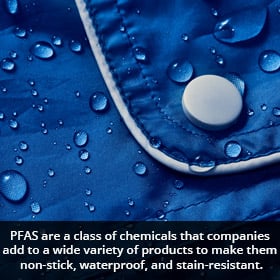
PFAS – The Quest for Alternatives to Harmful “Forever Chemicals”
PFAS (per- and polyfluoroalkyl substances) are very much in the news these days. These substances, which are also referred to as “forever chemicals” have been found in the air, drinking water and soil, and are linked to health issues in humans and animals. In this issue, we’ll talk about these chemicals, the challenges they pose, and what’s being done to find viable substitutes.
The Work to Understand PFAS and their Harmful Effects is Ongoing – Here’s What We Know:

- PFAS chemicals are long-lasting; they break down very slowly over time.
- Many consumer products that we use daily contain PFAS including clothing, furniture, carpets, cars, cell phones, aircraft, computers, appliances, firefighting foams, and many more.
- PFAS are a critical part of the fluoropolymer and fluoro-elastomer manufacturing process.
- Scientific studies have shown that exposure to some PFAS in the environment may be linked to harmful health effects.
- PFAS have been detected in the blood of people and animals.
We also know that the EPA and other global regulators are forcing the issue on this matter in a big way. Our industry is actively looking for alternatives, but the timeline for a fix is shrinking very rapidly!
Sometimes It Pays to Look Backwards to Solve Current and Future Problems
TriStar’s R&D team has begun to look at the chemistries of the past to see if there is a solution for the future. The challenge has been to understand what existing materials can match fluoropolymers in terms of temperature range, wear resistance, low friction, electrical and thermal stability, and manufacturability. There are several candidate polymers already on the market, but none (so far) can truly duplicate what fluoropolymers and elastomers do.
Our current research is focused on a promising organic thermoset material that has some interesting properties:
- Operating temperatures of 200-300°C
- Low inherent coefficient of friction
- Excellent abrasion resistance
- Halogen-free
- Excellent thermal and dielectric values, chemical resistance, and low moisture absorption
In addition, we expect to introduce additional enhancements to physical strength and dielectric/thermal properties through the use of fillers.
This research is still very much ongoing, and while we see some characteristics that are encouraging, continued testing of mechanical, thermal, electrical and tribological values will tell us more about the effectiveness of this product and its viability as a PFAS replacement.
Through Research – And Collaboration – We Will Find a Solution
Along with our manufacturing partners, we are looking for ways to make a better fluoropolymer product that is kinder to the environment and to living things. Our hope (and expectation) is that the industry will find ways to address the PFAS issue just as we did with PFOAs in 2015.
For more information about the state of fluoropolymer and fluoro-elastomer regulatory situation please feel free to reach out to our engineering experts.









